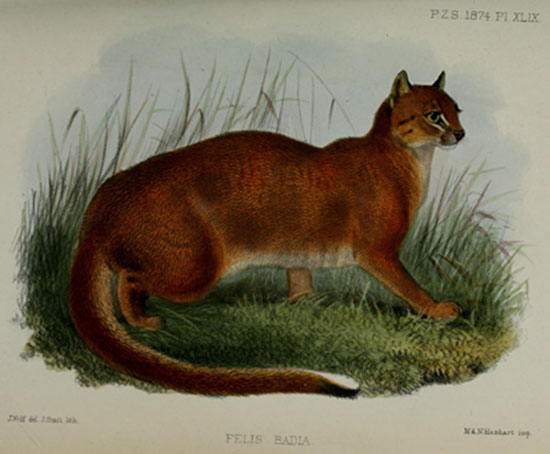4 Description of a new Species of Cat (Felis badia) from Sarawak. By Dr. J. E. GRAY, F.R.S. &c.
[Received April 29, 1874.]
(Plate XLIX.)
Mr. Wallace, in 1856, sent from Sarawak to the British Museum the skin of a small Cat (unfortunately so torn in being taken off as not to be able to be stuffed) and its skull.
I have been waiting, in the hopes of getting a skin in more perfect condition; but as none has arrived I think it as well to describe the torn specimen, and draw the attention of naturalists to the existence of a small long-tailed Cat, of a nearly uniform reddish-brown colour, from that country.
The skull has the short rounded face, and the back of the orbit interrupted, as in the restricted genus Felis, and belongs to an animal that, though it was not aged, had reached nearly the adult age.
The skin is of a uniform or self-colour, like the Puma, the Eyra, and the Jaguarondi of South America, and agrees with them in the cheeks behind the eyes being coloured like the rest of the head, and destitute of the two pale rays from the back of the eye, so particular in most of the Cats of the Old World*.
FELIS BADIA. (The Bornean Bay Cat.) (Plate XLIX.)
Fur of a bright chestnut-colour, rather paler beneath, the limbs and the tail being rather paler and redder. The tail is elongate, tapering at the end, with a white central streak occupying the hinder half of the lower side, gradually becoming wider and of a purer white towards the tip, which has a small black spot at its upper end. The ears are rounded, covered with short blackish-brown fur at the outer side, paler brown within, and with a very narrow pale margin. The sides of the upper lip, a small spot on the front angle, and the edge of the upper eyelid pale brown. The chin, edge of the under jaw, and gullet whitish.
Hab. Borneo, Sarawak (Wallace). B.M.
This Cat has been thought to be a kitten of Felis temmincki of Sumatra and Nepaul; but that is a much larger species, and the skull proves this to be a nearly full-grown animal. The difference of the colouring of the head, with the two streaks at the back of the eye, would distinguish even the kitten of F. temmincki from F. badia.
The tail of F. temmincki agrees with that of F. badia in being whitish on the underside at the end, but is not so decidedly and definitely white as that of F. badia; and it has not the very character-
*Mr. Wolf, in the drawing of this Cat, indicates two palish streaks on the cheeks, which I cannot make out in the specimen, which is in a rather bad state.
istic black spot on the upper part of its tip; and the tail of F. badia tapers gradually towards the tip, while those of the specimens of F. temmincki in the Museum are of the same width, and cylindrical, the whole of the length to the tip; but perhaps the tail of the very young kitten of this Cat may be more tapering.
June 2, 1874.
Arthur Grote, Esq., F.Z.S., in the Chair.
The Secretary read the following report on the additions to the Society's Menagerie during May 1874:—
The total number of registered additions to the Society's Menagerie during the month of May was 137, of which 62 were by birth, 31 by presentation, 18 by purchase, 1 received in exchange, and 25 received on deposit. The total number of departures during the same period, by death and removals, was 102.
The most noticeable additions during the month were:—
1. A Blue-faced Green Amazon Parrot, Chrysotis bouqueti (Bechst.), obtained by purchase May 6th, and said to have been brought from Honduras, though I think its more probable habitat is one of the Antilles.
Dr. Finsch says of this bird that it is so rare that he has never been able to examine a specimen, alive or dead.
2. A young male Koodoo (Tragelaphus strepsiceros), purchased May 12th. This animal is in very poor condition, but is progressing favourably, and was thought a desirable purchase, as we have already a fine female of the same species in the collection.
3. An example of the Raccoon-like Dog, Nyctereutes procynides (Gray), purchased May 21st, said to have been brought from one of the Russian settlements on the Amoorland, where v. Schenck has noted its occurrence (Amur-Reise, i. p. 53).
Of this rare carnivore, of which the present specimen is the only living example I have ever seen, I exhibit a water-colour drawing by Mr. Keulemans (Plate L.).
4. The two Whimbrels announced as having been sent by the Rev. S. J. Whitmee, C.M.Z.S., in his letter read at the meeting on March 17th*, from Quiros Island. These birds are apparently referable to Numenius femoralis, Peale, but cannot be certainly determined while alive.
The Didunculus sent by Mr. Whitmee on the same occasion unfortunately died before reaching this country.
5. A Beisa Antelope, Oryx beisa (Rüppell), obtained at Aden, and presented to the Society by Admiral Arthur Cumming, of H.M.S. 'Glasgow,' Flag-ship at Bombay, May 28th.
We have never before had a specimen of this fine Antelope in the
*See anteà, p. 183.
